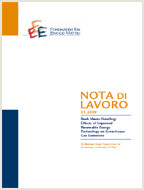China’s Pursuit of Environmentally Sustainable Development: Harnessing the New Engine of Technological Innovation

11.02.2016
Q55, Q58, Q43, Q48, O13, O31, O33, O44, F18
Endogenous Technological Change, Sustainable Development, Economic Growth Model, China's Economic Transition
Climate Change: Economic Impacts and Adaptation
Francesco Bosello
Whether China continues its business-as-usual investment-driven, environment-polluting growth pattern or adopts an investment and innovation-driven, environmentally sustainable development holds important implications for both national and global environmental governance. Building on a Ramsey-Cass-Koopmans growth model that features endogenous technological change induced by R&D and knowledge stock accumulation, this paper presents an exposition, both analytically and numerically, of the mechanism underlining China’s economic transition from an investment-driven, pollution-intensive to an investment and innovation-driven, environmentally sustainable growth path. We show that if R&D technological innovation is incorporated into China’s growth mechanism, then at some tipping point in time when marginal welfare gain of R&D for knowledge accumulation becomes equalized with that of investment for physical asset deployment, China’s economy will launch capital investment and R&D simultaneously and make a transition to a sustainable growth path along which consumption, capital investment, and R&D have a balanced share of 5: 4: 1, consumption, capital stock, and knowledge stock all grow at a rate of 4.9%, and environmental quality improves at a rate of 2.5%. In contrast, if R&D technological innovation is not harnessed as a new growth engine, then China’s economy will follow its business-as-usual investment-driven growth path along which standalone accumulation of dirty physical capital stock will lead to an more than 200-fold increase in environmental pollution.
***
Suggested citation: Jin, W., Z. Zhang, (2016), ‘China’s Pursuit of Environmentally Sustainable Development: Harnessing the New Engine of Technological Innovation’, Nota di Lavoro 24.2016, Milan, Italy: Fondazione Eni Enrico Mattei
